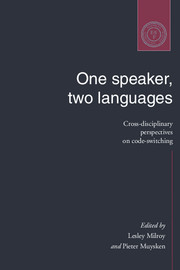Book contents
- Frontmatter
- Contents
- Notes on contributors
- Acknowledgments
- 1 Introduction: code-switching and bilingualism research
- Part one Code-switching in institutional and community settings
- Part two Code-switching and social life
- Part three Grammatical constraints on code-switching
- 9 Code-switching and grammatical theory
- 10 Patterns of language mixture: nominal structure in Wolof-French and Fongbe-French bilingual discourse
- 11 A lexically based model of code-switching
- Part four Code-switching in bilingual development and processing
- Index
9 - Code-switching and grammatical theory
Published online by Cambridge University Press: 05 June 2012
- Frontmatter
- Contents
- Notes on contributors
- Acknowledgments
- 1 Introduction: code-switching and bilingualism research
- Part one Code-switching in institutional and community settings
- Part two Code-switching and social life
- Part three Grammatical constraints on code-switching
- 9 Code-switching and grammatical theory
- 10 Patterns of language mixture: nominal structure in Wolof-French and Fongbe-French bilingual discourse
- 11 A lexically based model of code-switching
- Part four Code-switching in bilingual development and processing
- Index
Summary
In the last fifteen years, a large number of studies have appeared in which specific cases of intra-sentential code-switching were analysed from a grammatical perspective, involving a variety of language pairs, social settings and speaker types. It was found that code-switching is a quite normal and widespread form of bilingual interaction, requiring a great deal of bilingual competence. In individual cases, intra-sentential code-switching is not distributed randomly in the sentence, but rather it occurs at specific points.
Where much less agreement was reached is with respect to general properties of the process. Various ‘constraints’ and ‘models’ regulating intra-sentential code-switching (the type most interesting from the grammatical perspective) have been proposed and tested, with the result that some cases appear to fall under one constraint, and others under another. This is by itself unsatisfactory. We do not know in any systematic way how different the models proposed are, neither intrinsically nor in their predictions. It should be mentioned at this point that many of the studies do not make the constraints or models very explicit, limiting themselves to descriptive statements. Therefore, an account is needed of the grammatical notions relevant to code-switching. These notions can then be used both to characterise specific instances of intra-sentential switching and to relate the various proposals in the literature to each other.
Information
- Type
- Chapter
- Information
- One Speaker, Two LanguagesCross-Disciplinary Perspectives on Code-Switching, pp. 177 - 198Publisher: Cambridge University PressPrint publication year: 1995
Accessibility standard: Unknown
Why this information is here
This section outlines the accessibility features of this content - including support for screen readers, full keyboard navigation and high-contrast display options. This may not be relevant for you.Accessibility Information
- 86
- Cited by
